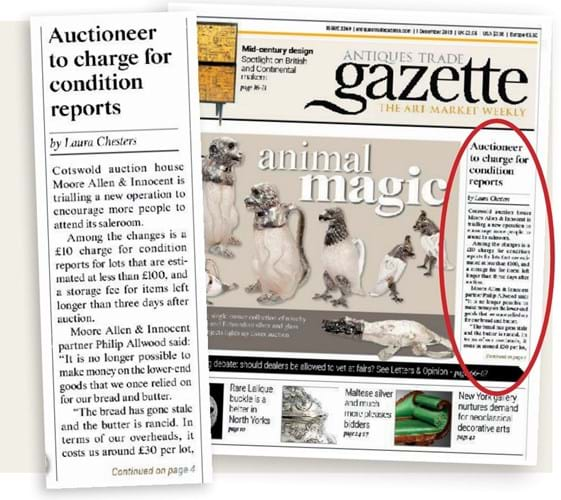
A few years ago I ‘retired’ as a philatelic auctioneer. During my working life of over half a century I was a director of Stanley Gibbons Auctions and then a senior director with Sotheby’s.
What always mystified me when joining Sotheby’s was the world of condition reports. They presented the expert staff with nightmares up to and including the sale period.
In the auction world of stamps, coins and medals, condition reports form an integral part of the catalogue entry.
To illustrate: the condition of a stamp, whether mint or used or used on a letter, is always mentioned with statements such as ‘fine but with a small crease’, ‘mint condition but the gum has been applied at a later date’ and so on. Condition reports are never prepared as they are there for all to read in the description.
Improved transparency
Now, why is it that some fine art auctioneers do not include relative comments in their descriptions such as ‘Victorian dining table – we believe three legs are original, the fourth may have been replaced at a later date’?
Until their clients get used to this transparency, a notice could be included in the catalogue saying ‘we no longer provide condition reports as all relative information is now incorporated in the catalogue entry’.
To try to charge for condition reports questions what buyers are getting for the buyer’s premium – now often 20% or even 25%.
I expect there will be all manner of weak excuses why this can’t happen, but we all know that if a cataloguer was worth their pay it would take fleeting moments to incorporate condition reports within the cataloguing.
Richard Ashton
Make bitter pill better
MADAM – As a buyer, I have always struggled to swallow the buyer’s premium ‘pill’ applied by auctioneers.
What, I ask myself, am I getting in return for the privilege of paying this excessive fee?
Only one thing comes to mind: that of asking for, and being provided with, a condition report.
Now it seems that someone (D Cavanagh, Letters, ATG No 2373) thinks it is a good idea to encourage auctioneers to charge for each and every condition report in addition to the buyer’s premium.
Some considerate auctioneers include a condition report within each lot description. As I do not buy damaged lots, I find this very helpful and I would encourage all auction houses to adopt this practice.
Doing so would definitely make that ‘pill’ easier to swallow.
John Hardmeier
Suffolk
Condition report fee is not fair
MADAM – I write with reference to the various correspondences in your excellent journal concerning high auction house fees.
As a member of the public with interests in Arts & Crafts, studio pottery and general antiques, it irks me that so many auctioneers find it quite acceptable to regularly increase ‘buyer’s commission’ – and now, to charge a fee for a condition report has to be the absolute limit of money-grabbing in the trade.
That so many rooms also no longer accept entire house-contents clearances somewhat debunks the concept of an auctioneer of chattels. So many rooms seem to think that they are beyond household clearances, on which their entire trade has been founded. Many rooms will no longer accept items that in their view are worth less than £200 – quite extraordinary!
While Mr Cavanagh in Edinburgh Letters, ATG No 2373) may believe that charging a condition report fee is justifiable, he cannot surely believe that a £10 + VAT charge is fair.
To buy a lot for £100 plus a further premium of, say, 25% inc VAT, makes that item over-priced. There’s going to be a lot of unsold stock in the trade.
I realise that some readers of the ATG will disagree with such a view but I surmise that just as many, or more, will wholeheartedly agree.
A fee for a condition report is not reasonable, not justified and not fair.
Stephen Hargreaves-Woodruff
Sussex












